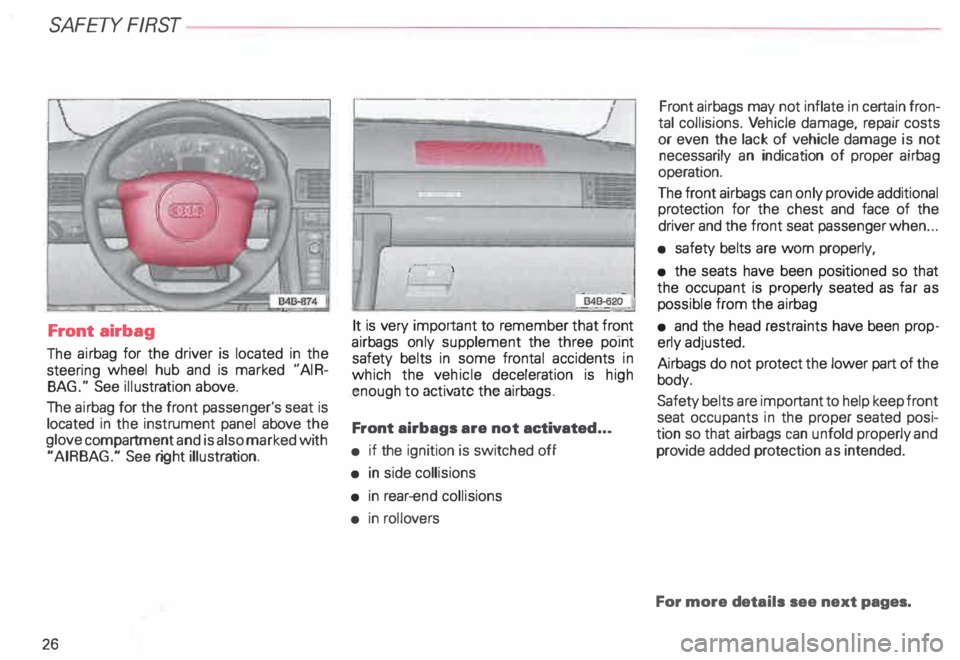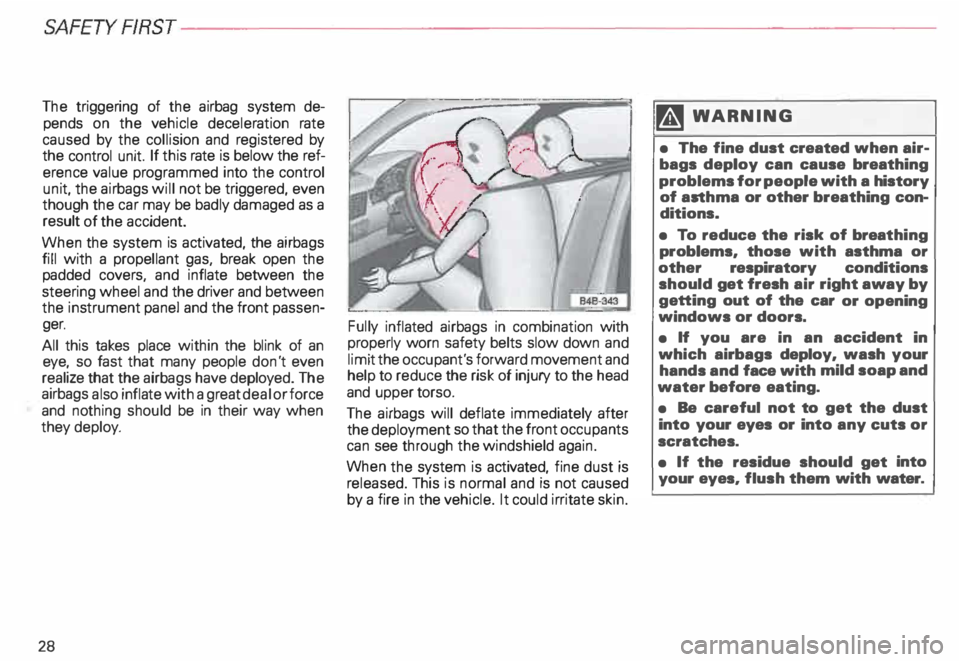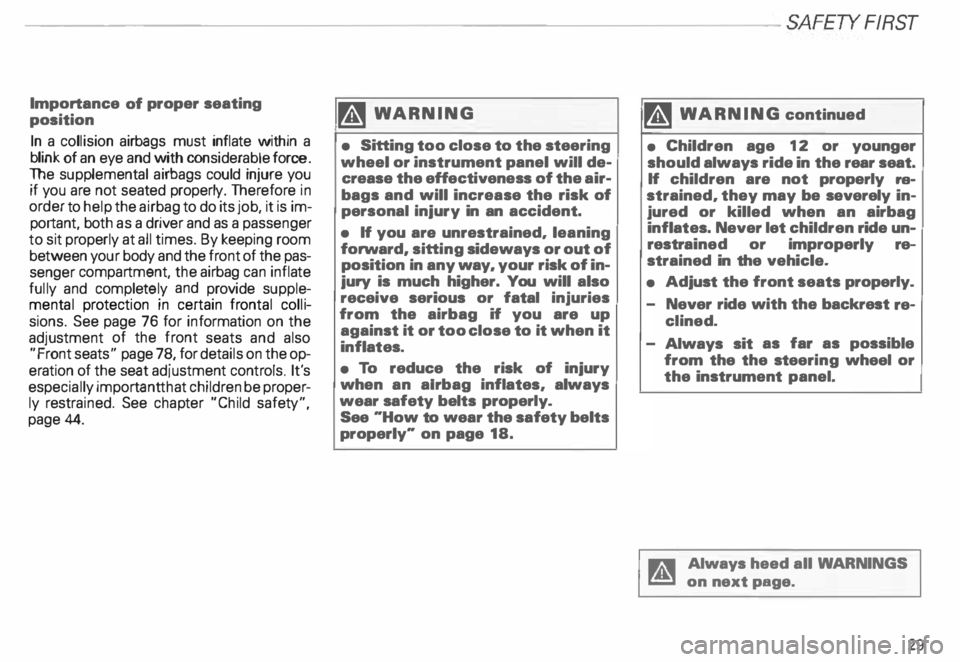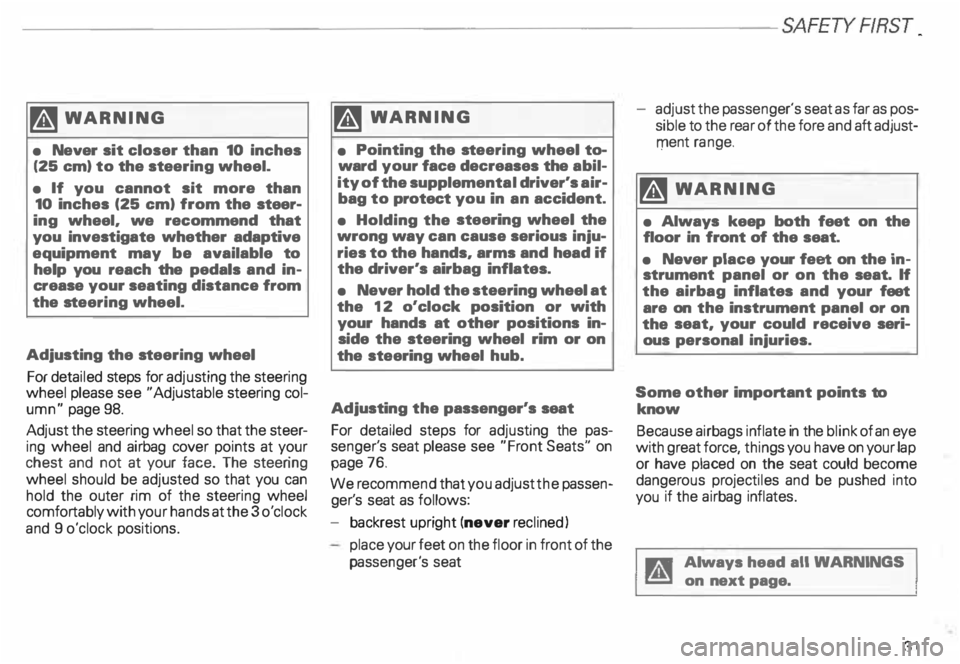2000 AUDI ALLROAD instrument panel
[x] Cancel search: instrument panelPage 26 of 306

---------------------------------------------------SAFETY RRST
Airbag system
Your vehicle has two front and four
side airbags, one front and one side air
bag for each front seat occupant, one side
airbag" for each rear seat occupant sitting
on the left and right rear seat.
In addition, your vehicle is equipped with
head airbags* on the left and right sides to
protect occupants seated next to the front
and rear doors. System
components
The airbag system consists of the following:
• electronic control module,
• an inflatable airbag with gas generator in
side the steering wheel,
• an inflatable airbag with gas generator in
side the instrument panel tor the front pas
senger,
• supplemental side airbags in the back
rest padding of the front and rear seats*,
• an inflatable curtain head airbag above
the doors on each side,
• an AIRB AG indicator light in the
instrument cluster ( see "Warning I Indica
tor lights" page 125).
The indicator light in the instrument cluster
(readiness light) will light up for a few sec
onds each time the ignition is switched on.
The light monitors the electronic control
module, sensor circuits, and system wiring. The
system must be inspected
if the indicator light:
• does not come on when the ignition is
switched on,
• does not go out after a few seconds after
the ignition is switched on, or
• comes on while driving.
In the event of a system malfunction, the in
dicator light will stay on continuously to
serve as a constant reminder to have the
system repaired.
�W ARNING
If any of these conditions occur,
have the alrbag system inspected
immediately by your Audi Dealer.
Otherwise, the airbags in your ve
hicle may not work properly in
case of a frontal collision or a side
impact.
25
Page 27 of 306

SA
FETY FIRST
Front airbag
The airbag for the driver is located in the
steering wheel hub and is marked "AIR
BAG." See illustration above.
The airbag for the front passenger's seat is
located in the instrument panel above the
glove compartment and is also marked with
"AIRBAG." See right illustration.
26 It
is very important to remember that front
airbags only supplement the three point
safety belts in some frontal accidents in
which the vehicle deceleration is high
enough to activate the airbags.
Front airbags are not activated ...
• if the ignition is switched off
• in side collisions
• in rear-end collisions
• in roiJovers Front
airbags may not inflate in certain fron
tal collisions. Vehicle damage, repair costs
or even the lack of vehicle damage is not
necessarily an indication of proper airbag
operation.
The front airbags can only provide additional
protection for the chest and face of the
driver and the front seat passenger when ...
• safety belts are worn properly,
• the seats have been positioned so that
the occupant is properly seated as far as
possible from the airbag
• and the head restraints have been prop
erly adjusted.
Airbags do not protect the lower part of the
body.
Safety belts are important to help keep front
seat occupants in the proper seated posi
tion so that airbags can unfold properly and
provide added protection as intended.
For more details see next pages.
Page 29 of 306

SAFETYRRST---------------------------------------------------
The triggering of the airbag system de
pends on the vehicle deceleration rate
caused by the collision and registered by
the control unit. If this rate is below the ref
erence value programmed into the control
unit, the airbags will not be triggered, even
though the car may be badly damaged as a
result of the accident.
When the system is activated, the airbags
fill with a propellant gas, break open the
padded covers, and inflate between the
steering wheel and the driver and between
the instrument panel and the front passen
ger.
All this takes place within the blink of an
eye, so fast that many people don't even
realize that the airbags have deployed. The
airbags also inflate with a great deal or force
and nothing should be in their way when
they deploy.
28 Fully
inflated airbags in combination with
properly worn safety belts slow down and
limit the occupant's forward movement and
help to reduce the risk of injury to the head
and upper torso.
The airbags will deflate immediately after
the deployment so that the front occupants
can see through the windshield again.
When the system is activated, fine dust is
released. This is normal and is not caused
by a fire in the vehicle. It could irritate skin. �W
ARNING
• The fine dust created when air
bags deploy can cause breathing
problems for people with a history
of asthma or other breathing con
ditions.
• To reduce the risk of brea thing
problems, those with asthma or
other respiratory conditions
should get fresh air right away by
getting out of the car or opening
windows or doors.
• If you are in an accident in
which airbags deploy, wash your
hands and face with mild soap and
water before eating.
• Be careful not to get the dust
into your eyes or into any cuts or
scratches.
• If the residue should get into
your eyes, flush them with water.
Page 30 of 306

--------------------------SAFETY FIRST
Importance
of proper seating
position
In a collision airbags must inflate within a
blink of an eye and with considerable force.
The supplemental airbags could injure you
if you are not seated properly. Therefore in
order to help the airbag to do its job, it is im
portant, both as a driver and as a passenger
to sit properly at all times. By keeping room
between your body and the front of the pas
senger compartment, the airbag can inflate
fully and completely and provide supple
mental protection in certain frontal colli
sions. See page 76 for information on the
adjustment of the front seats and also
"Front seats" page 78, for details on the op
eration of the seat adjustment controls. It's
especially importantthat children be proper
ly restrained. See chapter "Child safety",
page 44. �W
ARNING
• Sitting too close to the stee ring
wheel or instrument panel will de
crease the effe ctiveness of the air
bags and will increase the risk of
personal injury in an accident.
• If you are unrestrained, leaning
forward, sitting sideways or out of
position in any way. your risk of in
jury is much higher. You will also
receive serious or fatal injuries
from the airbag if you are up
against it or too close to it when it
inflates.
• To reduce the risk of injury
when an alrbag inflates, always
wear safety belts properly.
See "How to wear the safety belts
properly" on page 18. '4
WARNING continued
• Children age 12 or younger
should always ride in the rear seat.
If children are not properly re
strained, they may be severely in
jured or killed when an airbag
inflates. Never let children ride un
restr ained or improperly re
strained in the vehicle.
• Adjust the front seats properly.
- Never ride with the backrest re-
clined.
- Always sit as far as possible
from the the stee ring wheel or
the instrument panel.
Always heed all WA RNINGS
on next page.
29
Page 32 of 306

-----------------------------------------------------SAFETY RRST
�W ARNING
• Never sit closer than 10 inches
(25 em) to the stee ring wheel.
• If you cannot sit more than
10 inches (25 em) from the steer
ing wheel, we recommend that
you investigate whether adaptive
equipment may be available to
help you reach the pedals and in
crease your seating distance from
the steering wheel.
Adjusting the steering wheel
For detailed steps for adjusting the steering
wheel please see "Adjustable steering col
umn" page 98.
Adjust the steering wheel so that the steer
ing wheel and airbag cover points at your
chest and not at your face. The steer ing
wheel should be adjusted so that you can
hold the outer rim of the steering wheel
comfortably with your hands at the 3 o'clock
and 9 o'clock positions. �W
ARNING
• Pointing the steering wheel to
ward your face decreases the abil
ity of the supplementa l driver's air
bag to protect you in an accident.
• Holding the steering wheel the
wrong way can cause serious inju
ries to the hands, arms and head if
the driver's airbag inflates.
• Never hold the steering wheel at
the 12 o'clock position or with
your hands at other positions in
side the steering wheel rim or on
the steering wheel hub.
Adjusting the passenger's seat
For detailed steps for adjusting the pas
senger's seat please see "Front Seats" on
page 76.
We recommend that you adjust the passen
ger's seat as follows:
- backrest upright (never reclined)
place your feet on the floor in front of the
passenger's seat adjust
the passenger's seat as far as pos
sible to the rear of the fore and aft adjust-
1)1ent range.
�W ARNING
• Always keep both feet on the
floor in front of the seat.
• Never place your feet on the in
strument panel or on the seat. If
the airbag inflates and your feet
are on the instrument panel or on
the seat, your could receive seri
ous personal injuries.
Some other important points to
know
Because airbags inflate in the blink of an eye
with great force, things you have on your lap
or have placed on the seat could become
dangerous projectiles and be pushed into
you if the airbag inflates.
Always head all WARNINGS
on next page.
31
Page 33 of 306

SAF
ETY RRST---------------------------------------------------
. � WARNING
• Objects between you and the
airbag can increase the risk of in
jury in an accident by interfering
with the way the airbag unfolds or
by being pushed into you as the
airbag inflates.
• Never hold things in your hands
or on your lap when the vehicle is
in use.
• Never place or attach accesso
ries or other objects (such as cup
holders, telephone brackets or
even large and bulky objects) on
the doors, over or near the area
marked ,. Airbag" on the steering
wheel, instrument panel, seat
backrests or between those areas
and yourself. These objects could
cause injury in a crash especially
when the airbags inflate.
32 �,
WARNING continued
• Never transport items on or in
the area of the front passenger
seat. Objects could move into the
area of the front alrbags during
braking or other sudden maneuver
and become dangerous projectiles
that can cause serious personal in
jury if the airbags inflate.
• Never recline the front passen
ger's seat to transport objects.
Items can also move into the area
of the side airbags or the front air
bag during braking or sudden ma
neuver. Objects near the airbags
can become projectiles and cause
injury particularly when the seat is
reclined. Child
restraints on the front seat -
important things to know
All children, especially 12 years old and
younger should always ride in the back seat
properly restrained for their age and size.
The ai rbag on the passenger side makes the
front seat a potentially dangerous place for
a child to ride. The front seat is not the saf
est place for a child in a forward-facing child
seat. It is a very dangerous place for an in
fant or a larger child in a rearward-facing
seat.
• Never install rear-facing child
seats or infant carriers on the front
passenger seat. A child will be se
riously injured and can be killed
when the passenger airbag in
flates.
Page 44 of 306

-------------------------------------------------SAFETY RRST
'4 WARNING continued
• Any work on the airbag system.
such as removing/insta lling, re
pairing . or any work on the steer
ing wheel. instrument panel. front
seats or electrical system (Includ
ing the installation of audio equip
ment. mobile telephones and CB
radios. etc.) must be performed by
a qualified technician who has the
. training and special equipment
necessary. Improper handling may
result in injury.
• For any work on the airbag sys
tem. we strongly recommend that
you see your Audi Dealer.
• The alrbag system can be acti
vated only once. After an alrbag
has inflated. it must be replaced. Please
be sure that this manual al
ways remains with your Audi when
ever you lend your vehicle to
another person or if you sell it so
that this and other important infor
mation will always be available to
the driver and passengers.
43
Page 77 of 306

CONTROLS ANDEOUWMENT-----------------------------------------
Front seats
The correct positioning of the seats is im
porta nt:
so that you can reach all the controls on
the vehicle quickly and safely;
so that you can drive or ride relaxed and
help reduce fatigue;
and for maximum protection of
fered by the safety belts and air
bag system.
Therefore, always adjust the position of the
seat as described on the following pages.
Remember to adjust the seats before fas
tening the safety belts and before driving
off. Always be sure to follow these general
guidelines:
76 m
WARNING
• Always sit as far away from the
stee ring wheel and the instrument
panel as possible.
• Never sit less than 10 inches
(25 em.) from the steering wheel
and the instrument panel.
• Do not adjust seats while the ve
hicle is moving. Your seat may
move unexpectedly, causing sud·
den loss of vehicle control and
personal injury.
• Passengers must always keep
their feet on the floor whenever
the vehicle is moving. Never place
feet on the dashboard or on top of
the seats. In an accident, serious
personal injury can result from an
improper seating position. BSN-163
Driver's seat
To avoid contact with the airbag while it is
unfolding, the driver must not sit any closer
to the steering wheel than necessary and al
ways properly wear available three point
belts.